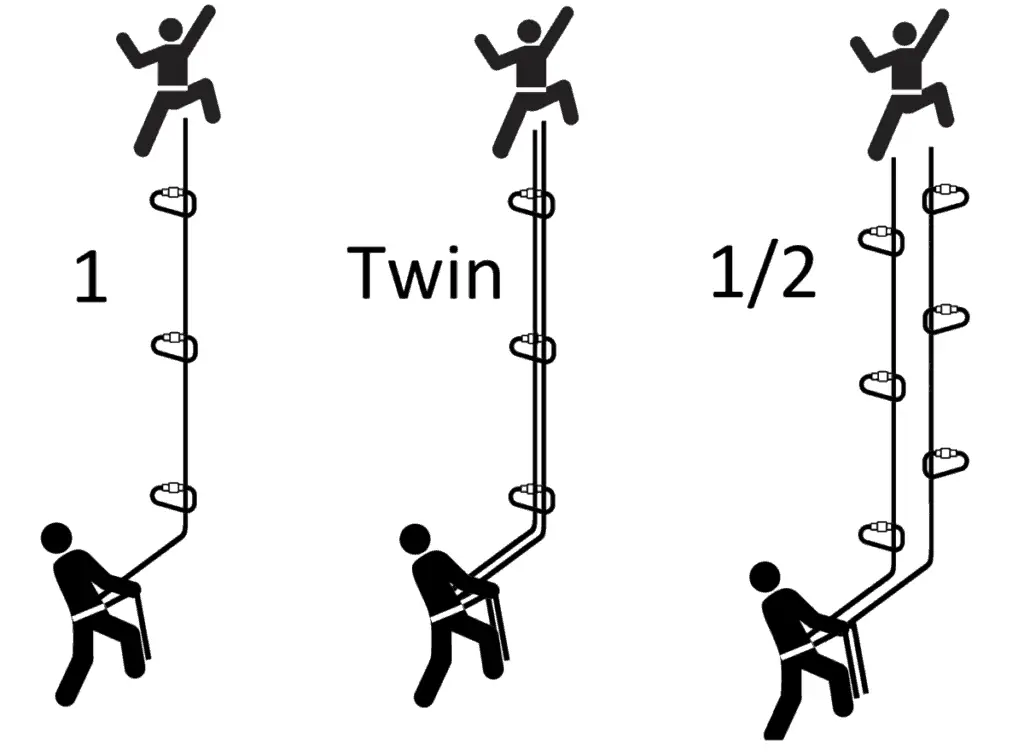Disclosure: Links marked with * are Affiliate Links. As an Amazon Associate, I earn from qualifying purchases if you decide to make a purchase through these links – at no cost for you!
You can use two different types of rope for climbing and mountaineering: static*, and dynamic climbing ropes*.
Knowing the difference – and taking into account the associated uses – is the first step towards accident-free climbing. If you use the wrong ropes, the results could be fatal in an accident.
The Difference between Static and Dynamic Ropes
Dynamic ropes are climbing ropes that are mainly used to catch a slipping or falling climber on the wall. The elasticity of such ropes serves to cushion the energy generated during a fall better.
Stretchy climbing ropes – i.e. dynamic ropes – must meet the requirements of EN 892 or equivalent. They should be so flexible that they can cushion the so-called “catch impact” when falling. At the same time, however, dynamic ropes must also be able to withstand loads in such a way that they do not tear in the event of a fall.
If someone were to use a (semi-)static climbing rope while climbing and then slip off, the rope would abruptly stop the stumbled climber – but due to a lack of elasticity with much more painful consequences.
With a maximum permitted elongation in use of no more than five percent, static ropes can be correctly described as semi-static fixed ropes. They’re 9 to 13 millimeters thick. Semi-static ropes are used in canyoning, in the construction of high rope courses or as safety ropes in height rescue. Cave explorers also use static ropes.
Semi-static ropes lead to serious injuries when falling due to the high impact force during climbing tours in the lead climb. A semi-static rope complies with the EN 1891 standard in terms of elongation and strength. It may only have a maximum strength and thickness. The life of a climbing colleague or accident victim can depend on this. Those who use thinner rope cords in the lead climb to rescue an injured person do not observe the most important rules of rope use.
Dynamic or static: the fall factor is relevant
The lifespan of each rope – regardless of whether it is dynamic or static – is measured, among other things, by its fall factor: The fall factor is equal to the fall length divided by the length of the working rope.
Depending on the use of the rope, the standard fall factor is 0 to 2. In secured fixed rope courses, however, it can also develop a higher force. In this case, the fall factor can be up to 7. This means that the impact force is extremely high under unfavorable conditions. It can make the rope break. This would inevitably result in serious injuries to the climber. This means, that you have to carry a special rope set on a fixed rope course, which includes a built-in shock absorber.
Other factors that can influence the service life of a climbing rope are:
- the frequency of use of the rope
- the correct use of the rope
- the age of the climbing rope
- the already visible abrasion
- the presence or absence of impregnation
- mechanical, thermal or chemical loads
- the number of falls already caught
- or the storage of the rope.
The relationship between impact force and fall factor
The rope structure, the fall factor and the bodyweight of a climber have an influence on the impact force. The way in which a climbing fan has secured himself is also relevant. Naturally, the age of climbing ropes and the number of falls they catch also play an important role. In the event of a fall, the energies acting on the climbing rope add up. For example, the tensile forces exerted by the fall end plus the tensile forces exerted by the securing partner on the rope come into play.
Every climbing fan should, therefore, be able to calculate how high the impact could be if he uses intermediate safety devices. The aim must be to keep the loads on the climbing rope caused by the impact as low as possible. Avoiding a fall is, of course, the most important measure. However, if you slip while climbing, you should be optimally secured and have correctly assessed the impact.
How could the impact force be kept actively smaller?
The first measure is that the first intermediate backup is applied as soon as possible. That already reduces the fall factor. This should always be kept as low as possible when climbing a fixed rope route. The following intermediate backup should be fitted as close as possible to each other. Energy absorbers are mainly used for ice climbing. Even if natural safety points are to be used, shock absorbers are useful.
The friction should be kept as low as possible by a loose rope guide at the securing points. In the event of a fall, the climbing rope can then become effective over its entire length. In addition to the use of a dynamic climbing rope, dynamic handling of falls can also be trained. A dynamic climbing rope can cushion a fall and reduce its consequences.
A static rope can’t do that. It does not absorb the released energies. For this reason, static climbing ropes, thick rope cords or webbing slings are never used on the rock. Even short falls into static webbing slings can lead to heavy loads on the rope, the nearby securing points or the climber himself.
What does a dynamic climbing rope look like from the inside?

Dynamic climbing ropes are designed to prevent a strong impact. The elasticity of such climbing ropes is just as important as their tensile strength. The manufacture of a dynamic climbing rope is therefore designed to meet both criteria.
The tensile strength, however, is a relative value at sharp rock edges and high friction intensity. If the tensile load is too high, material melting or cut climbing ropes sometimes occur on a sharp-edged rock ridge. However, this happens preferably in the case of improper use and incorrect storage, older ropes that have already exceeded their service life, and unfortunate chaining of circumstances.
The inner workings of a dynamic climbing rope consist of interwoven rope strands. These must not be interrupted over the entire rope length. The rope construction includes an elastic core, a control thread chosen differently each year for identification, and a sheath.
Polyamide fibers have proven to be the best material for dynamic climbing ropes. These synthetic fibers have exactly the elasticity, stretchability and strength required for dynamic climbing ropes. Other materials have proven to be less suitable for absorbing falls.
What does a static climbing rope look like from the inside?
The (semi-)static ropes also consist of interwoven textile fibers inside, which are surrounded by a protective sheath. Overall, the construction of semi-static ropes is similar to that of dynamic climbing ropes.
Here, however, the core of the rope should not yield under load. The load-bearing capacity of such ropes is therefore ensured by means of sheathed strands. The jacket prevents thermal, mechanical or other influences from damaging the interior.
Also here a control stripe is indicating its properties. This can provide the manufacturer with important information on a specific batch of material or a defined production period in the event of frequent rope damage.
Is a rope dynamic, semi-static or static?
This can be answered by the amount of elongation in use, i.e. the elongation that occurs when a rope is used. With dynamic climbing ropes, the maximum elongation is set at a maximum of eight percent. The manufacturer achieves this elongation through certain processes that act on the material during rope manufacture.
On the one hand, the twists of the rope core are interlaced and twisted in. On the other hand, they are shrunk in an autoclave by means of heat and pressure as well as a certain exposure time. This creates an expansion reserve.
It is an artificially produced elasticity, but it is not produced by elastic strings or stretchy materials.
A semi-static or static rope only has a maximum permitted elongation capacity of two to five percent. Various national or EU standards regulate how such ropes must be designed.
What is the difference between single ropes, half ropes and twin ropes?
There are three types of dynamic climbing ropes: The single rope*, the half rope* and the twin rope*. These can be recognized by a mark on the end of the rope.
The single rope has a round symbol on the left. A round symbol is attached to the top right of the half rope. The twin ropes have a round symbol at the bottom right.
Single ropes are preferably used in climbing gyms and high rope courses. Their diameter is between 8.9 and 11 millimeters. The requirements of the European standard EN 892 require that the single rope:
- withstands at least five falls from a climber weighing 80 kilograms
- survives a fall factor of 1.75
- absorbs an impact force of 12 kN during the first fall
- can withstand a maximum rope elongation of 10 percent under static load from a person weighing 80 kilograms
- and stretches by a maximum of 40 percent on the first “norm fall.”
Norm falls are fall simulations, which are today regarded as not sufficiently realistic. In the case of falls, the maximum permissible minimum sheath displacement is one percent.
Half ropes have a diameter of 8 to 9 millimeters. Sometimes half ropes are also called double ropes. The reason for this lies in their two rope lines, on which two climbers can secure themselves. Each one then uses his own strand. The lead climber must reckon with higher forces acting on the rope. He, therefore, uses two half ropes for securing. In order to generate reduced friction at the intermediate backups, it alternately attaches one of the two half rope strands to the intermediate backup.

Half ropes are slightly heavier than twin ropes. In the test, such ropes must be able to withstand a drop weight of 55 kilograms per single strand in the fall test with five standard falls. Two half ropes can be knotted for abseiling, as otherwise, only half the rope length would be available. In the past, the double rope technique described above was carried out with two single ropes.
Twin ropes are 7 to 8 millimeter thick ropes that are only used as double strands. They are mainly used on long routes where there are good intermediate safety points. You could also use these on the way back. In this case, two thinner twin ropes are used. Individual twin ropes cannot withstand a falling load. In alpine regions, climbers usually climb with half or twin ropes. Twin ropes, which are always used in double strands, must withstand 12 standard falls in the test and carry a weight of 80 kilograms.
Attention: You have to take care of your safety when climbing! The information on climbtheearth.com only helps you to learn. Before you climb, you should make sure that you have been properly instructed by an expert and that you follow all safety precautions.
Disclosure: This website is the property of Martin Lütkemeyer and is operated by Martin Lütkemeyer. Martin Lütkemeyer is a member of the Amazon Services LLC Affiliate Program, an affiliate advertising program designed to enable Web sites to earn advertising revenue through advertising and linking to Amazon.com. Links marked with * are affiliate links.

